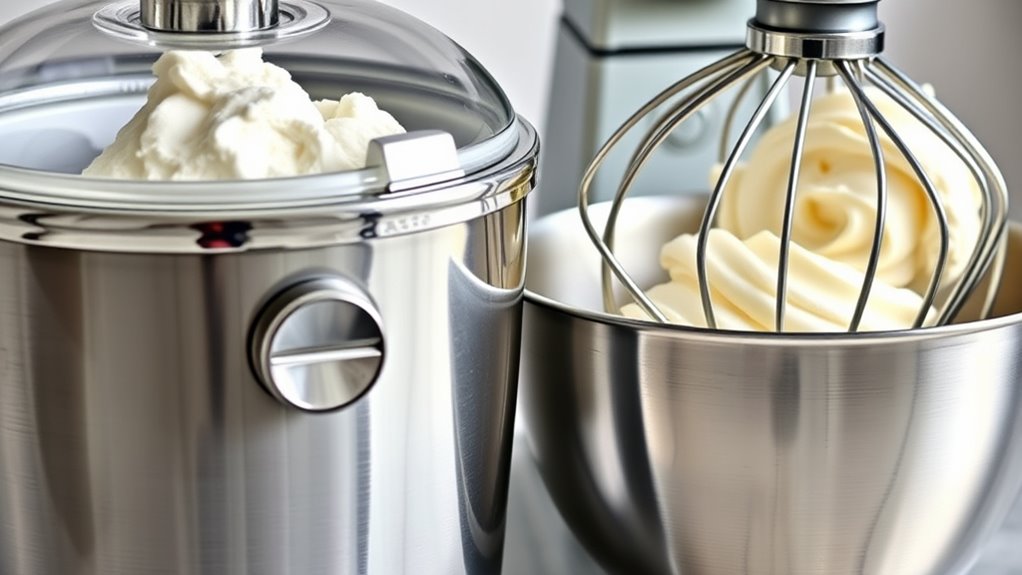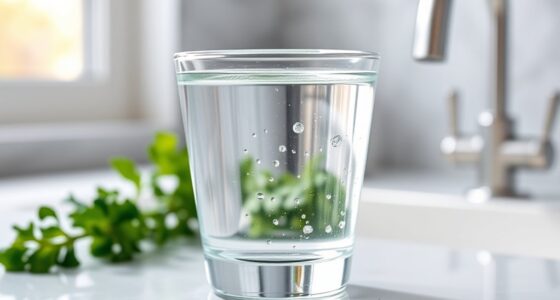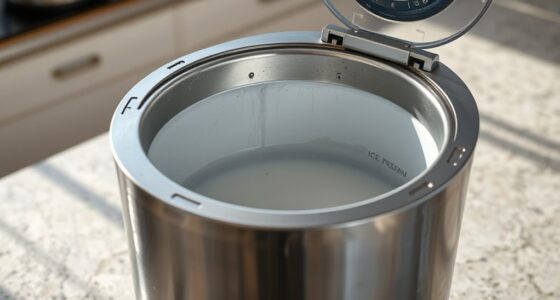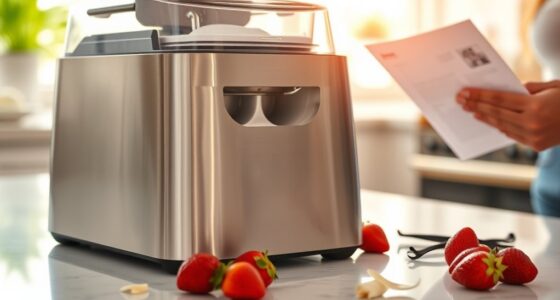If you want convenience and better ice cream quality, a standalone ice cream maker is often the best choice, especially for smoother textures and easier cleaning. However, if you already own a KitchenAid mixer, using an attachment can save space and money while still offering good results. The decision depends on your budget, available space, and how much control you want over ingredients. To discover which option suits your needs best, explore the details further.
Key Takeaways
- Ice cream makers generally produce smoother, creamier ice cream due to dedicated churning and refrigeration capabilities.
- KitchenAid attachments are more space-efficient and cost-effective if you already own a stand mixer.
- Standalone ice cream makers offer faster prep times with minimal assembly, while attachments require long pre-freezing periods.
- Ice cream makers tend to be noisier but deliver higher product quality; attachments are quieter but may have slightly less consistent texture.
- The best choice depends on budget, kitchen space, and desired ice cream quality; dedicated machines excel in creaminess, attachments in versatility.
Design and Ease of Use
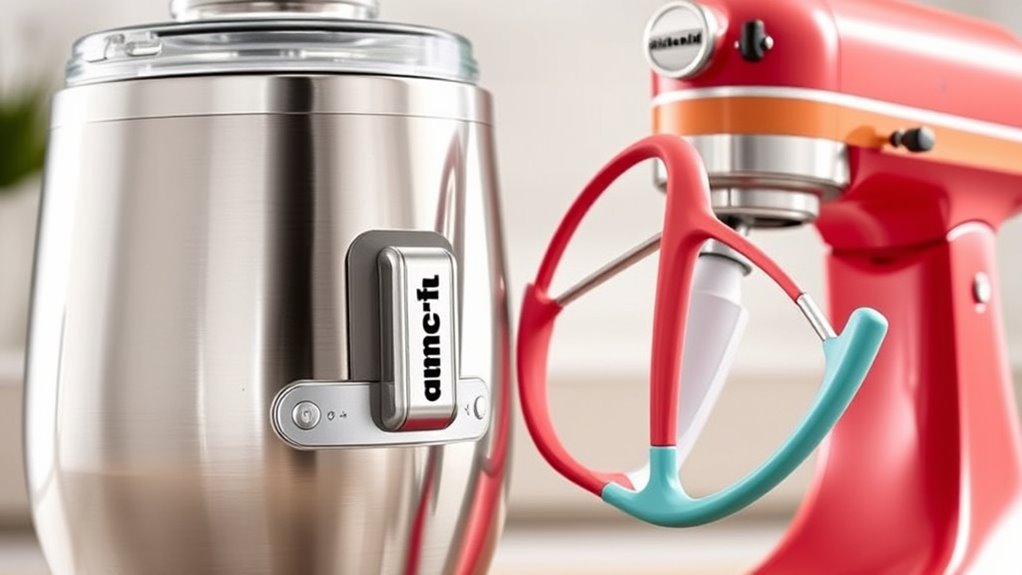
When comparing the design and ease of use between an ice cream maker and a KitchenAid attachment, it’s clear that each option offers different advantages. Ice cream makers are often standalone appliances with various color options, allowing you to choose one that matches your kitchen’s aesthetic appeal. They tend to be bulkier but straightforward, with simple controls to operate. KitchenAid attachments, on the other hand, integrate seamlessly with your stand mixer, saving counter space and maintaining a sleek look. The attachment’s design complements your mixer’s style, enhancing overall aesthetic appeal. Ease of use varies: ice cream makers require pre-freezing bowls and manual setup, while attachments operate quickly once installed. Both options prioritize convenience, but their design philosophies cater to different preferences.
Capacity and Serving Size

Capacity and serving size are key factors to contemplate when choosing between an ice cream maker and a KitchenAid attachment. Ice cream makers typically come with a bowl that holds a specific amount, usually enough for several servings, making it easier to prepare larger batches at once. This is ideal if you want to serve multiple people or store leftovers. The KitchenAid attachment, on the other hand, relies on your mixer’s bowl capacity, which can vary but often allows for sizable batches as well. Both options also offer great ingredient flexibility, enabling you to customize flavors and control sugar or add-ins. If you prefer making smaller, more frequent servings or experimenting with flavors, consider the capacity limitations to match your needs effectively.
Price and Overall Cost
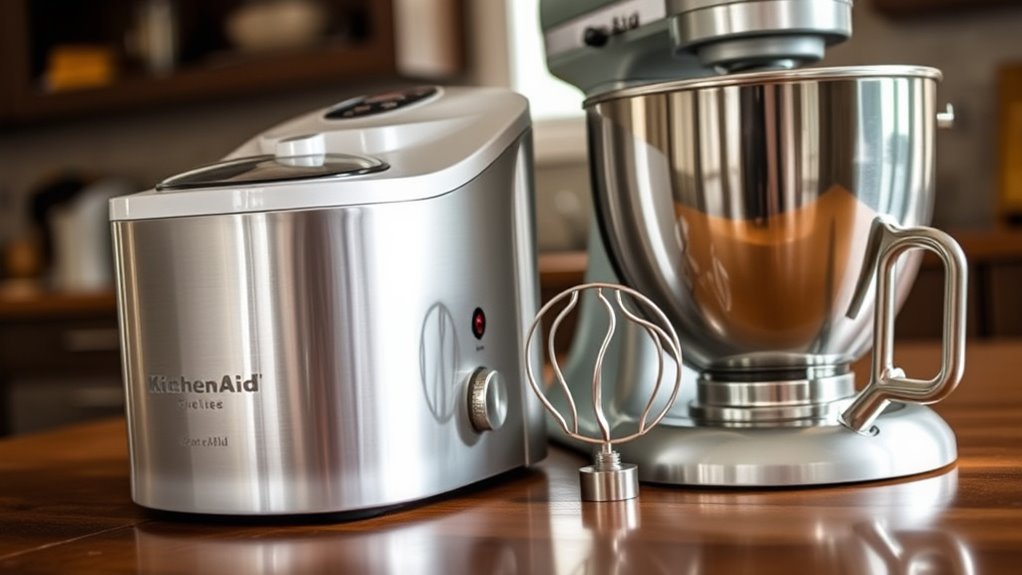
Price and overall cost play a significant role in deciding between an ice cream maker and a KitchenAid attachment. A thorough price comparison shows that standalone ice cream makers often have a lower upfront cost, making them more accessible if you’re on a budget. However, over time, the overall affordability of a KitchenAid attachment can be better, especially if you already own a KitchenAid mixer, since it eliminates the need for a separate appliance. Keep in mind that some ice cream makers may require additional accessories or maintenance costs, which can add up. Additionally, considering the durability and build quality involved can influence your long-term satisfaction and overall investment value. A well-made attachment can also provide versatility in culinary use, enhancing its value over time. The capacity and ease of use of each device are also important factors to consider for consistent results. Meanwhile, the KitchenAid attachment’s initial investment might seem higher, but its versatility and durability contribute to long-term value. Additionally, considering the projector technology involved can influence your long-term satisfaction and overall investment value. When assessing your options, it’s also useful to think about how the cost-efficiency of each appliance aligns with your usage frequency and culinary needs.
Preparation and Freezing Time
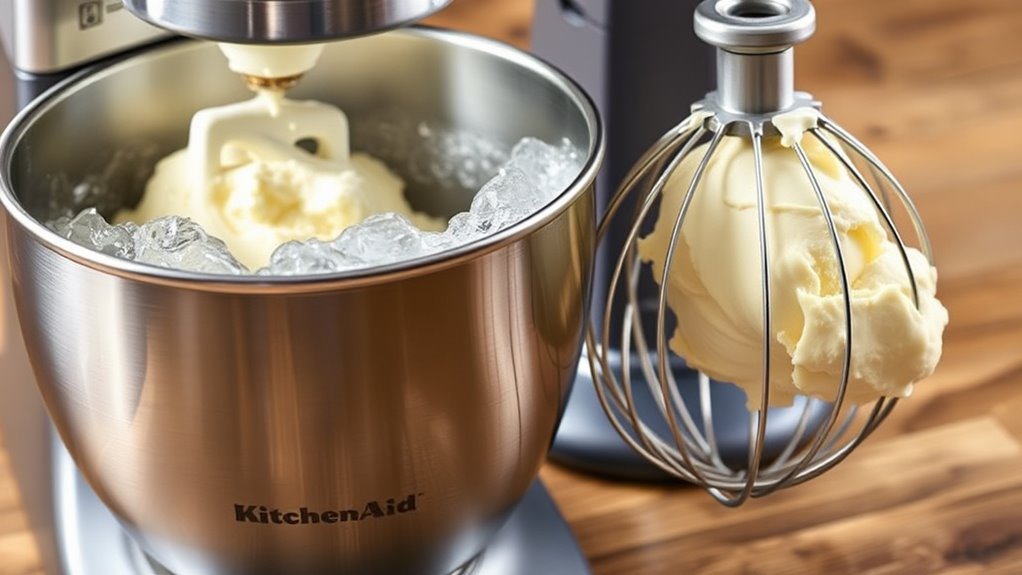
Preparing ice cream with a standalone machine typically involves a longer process, as you’ll need to chill the bowl or freezer bowl for several hours before making your mixture. Once ready, pouring in your ingredients—like frozen fruit—means you can skip pre-freezing your mixture, saving time. The machine then churns until the ice cream reaches a smooth, creamy texture, which usually takes about 20-30 minutes. In contrast, using a Kitchenaid attachment often requires you to freeze the bowl for at least 15 hours beforehand, adding to the overall prep time. While the attachment may be quicker during the churning stage, the total preparation time—especially for frozen fruit—tends to be longer. So, your choice depends on how much time you want to invest before enjoying your ice cream. Preparation time can vary significantly based on the method you choose, influencing your overall experience. Additionally, the freezing process for the attachment’s bowl can be a crucial factor in scheduling your ice cream making.
Maintenance and Cleaning
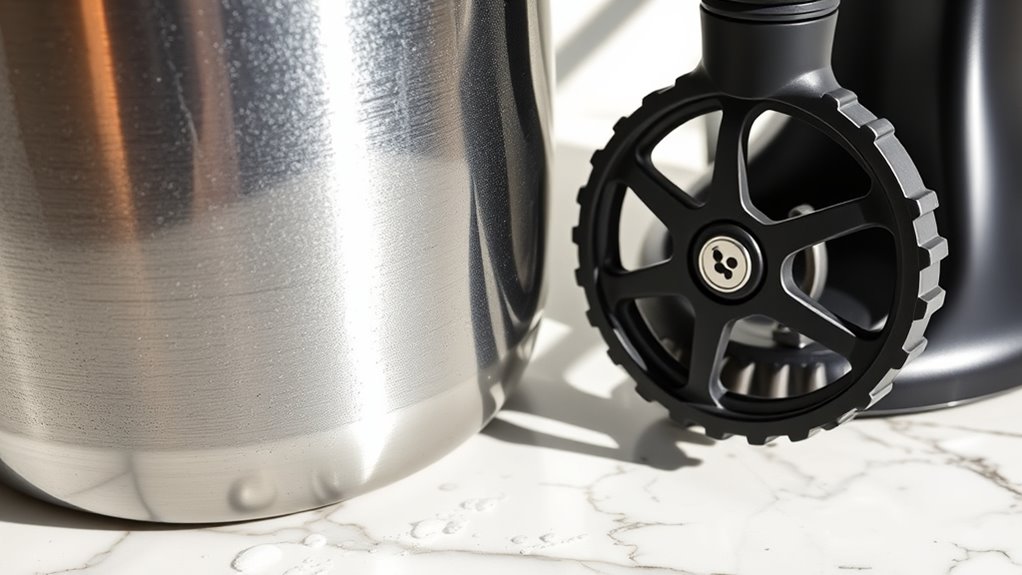
Keeping your ice cream equipment clean is straightforward, but the process varies between machines. You’ll want to understand each device’s maintenance needs to keep them running smoothly. Considering their durability also helps you decide which option will last longer with proper care. Regularly inspecting and cleaning appliance components can prevent buildup and ensure optimal performance, especially for appliances used frequently. Additionally, understanding filter replacement features can help you maintain air quality and prolong the life of your air purifier over time. Staying aware of AI security vulnerabilities can also contribute to safeguarding your appliances from potential cyber threats, ensuring they remain safe and reliable.
Cleaning Process Simplicity
Cleaning an ice cream maker can be straightforward if you understand the differences between the unit itself and the KitchenAid attachment. The standalone machine often has removable parts that are easy to wash, but some models require thorough disassembly. The KitchenAid attachment, on the other hand, involves cleaning the bowl and dasher, which may be more involved but still manageable. Both options offer flavor customization and ingredient flexibility, but their cleaning processes vary. Additionally, automation in kitchen appliances has led to simpler cleaning routines for many modern devices, making maintenance even easier. Properly adhering to wood stove safety standards and regular maintenance routines can also prevent issues that might complicate equipment cleaning or operation. For example, understanding the specific cleaning instructions for attachments can help prolong the life of your equipment and ensure optimal performance. Being aware of manufacturer guidelines is crucial for maintaining the integrity of your devices over time.
Maintenance Requirements Overview
Maintaining your ice cream maker or KitchenAid attachment involves regular upkeep to guarantee peak performance and longevity. You should pay attention to cleaning frequency, making sure you clean after each use to prevent residue buildup and bacteria growth. Some parts, like the paddle or bowl, may require occasional replacement if they show signs of wear or damage. Regular inspection helps identify parts that need replacing early, avoiding unexpected breakdowns. For the ice cream maker, cleaning the motor housing and removable parts is essential, while for the KitchenAid attachment, focus on the drive mechanism and paddle. Proper maintenance also involves drying components thoroughly before storage to prevent rust. Additionally, being aware of breast cancer symptoms can help in early detection and health maintenance, emphasizing the importance of regular health check-ups. Keeping up with these tasks ensures your appliance continues functioning efficiently and extends its lifespan.
Longevity and Durability
Since regular upkeep is essential for ensuring your ice cream maker or KitchenAid attachment lasts, focusing on proper maintenance and cleaning can considerably extend their lifespan. Material strength plays a key role; durable materials resist wear and tear better. Check warranty coverage to understand what repairs or replacements are included if issues arise. Proper cleaning prevents buildup that can weaken parts over time. Here’s a quick guide:
| Task | Recommended Frequency | Tips |
|---|---|---|
| Clean blades | After each use | Use warm water and soap |
| Lubricate moving parts | Monthly | Use food-safe lubricant |
| Inspect seals | Bi-monthly | Replace if damaged |
| Check motor and wiring | Annually | Ensure no fraying or corrosion |
| Store properly | When not in use | Keep in a dry, cool place |
Maintaining these steps helps maximize durability and protects your investment. Regularly inspecting materials used in your device can also help identify potential weaknesses early, ensuring long-term performance and longevity. Additionally, understanding the wear and tear process of various components aids in preventative maintenance. Being aware of common issues can help you address problems before they lead to significant damage. Conducting routine inspections can reveal early signs of deterioration and prevent costly repairs later.
Versatility and Additional Features
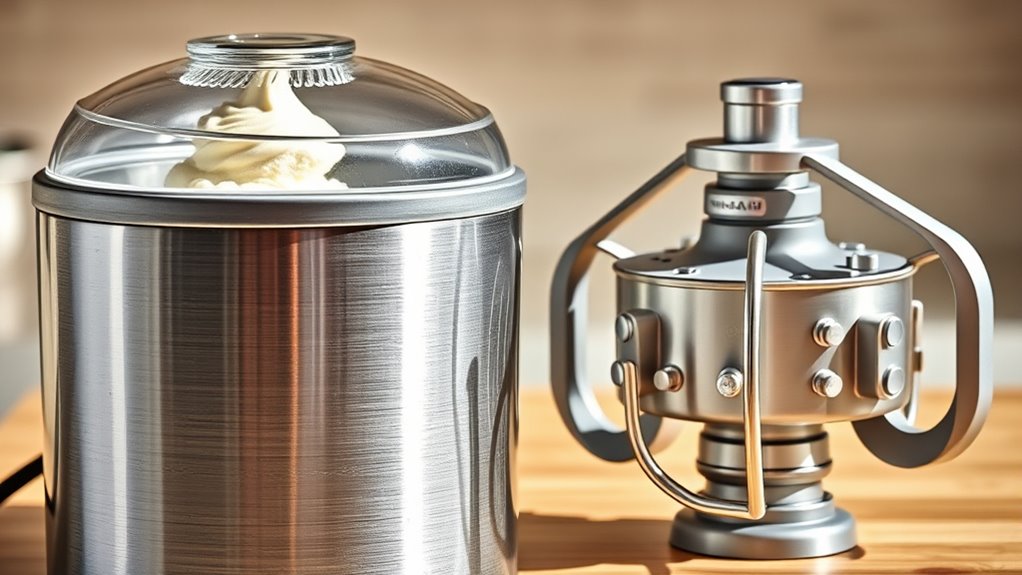
Both options offer a variety of recipes, letting you get creative with flavors and textures. The Kitchenaid attachment often includes extra features like making sorbet or frozen yogurt, adding to its versatility. Consider which device suits your cooking style and the range of treats you want to prepare. Additionally, the attachment can be used to create multifunctional desserts, enhancing its appeal for diverse culinary adventures. Its compatibility with different electric bike conversion kits highlights its adaptability for various kitchen needs. To maximize energy efficiency, ensure proper device maintenance and consider selecting models with high energy ratings.
Range of Recipes
When it comes to making a variety of frozen treats, the range of recipes each appliance can handle is a key factor to contemplate. An ice cream maker often offers greater flavor variety and ingredient flexibility, allowing you to experiment with dairy, fruits, nuts, and more. The KitchenAid attachment mainly focuses on basic ice cream and sorbets, limiting your options. To understand better:
| Feature | Ice Cream Maker | KitchenAid Attachment |
|---|---|---|
| Flavor Variety | High | Moderate |
| Ingredient Flexibility | Wide | Limited |
| Recipe Range | Extensive | Basic |
Choosing depends on how adventurous you want your recipes to be. An ice cream maker generally provides more options for creative flavor combinations.
Extra Functionality Options
While both an ice cream maker and a KitchenAid attachment can produce frozen desserts, their additional features and versatility vary markedly. An ice cream maker often offers preset functions, allowing you to experiment with flavor combinations and textures easily. It typically provides more control over the freezing process, enhancing flavor experimentation. The KitchenAid attachment, on the other hand, excels in ingredient flexibility, letting you incorporate ingredients like nuts, fruit chunks, or swirls directly into your mix. Its versatility extends beyond ice cream, enabling you to make sorbets, frozen yogurt, and even gelato with the right recipes. If you enjoy experimenting with flavors and customizing ingredients, both options serve you well, but the attachment’s adaptability offers broader functionality for creative frozen treats.
Quality of Final Product

The quality of the final ice cream depends heavily on the appliance you choose, as each method impacts texture, consistency, and flavor differently. An ice cream maker typically produces a creamier, more uniform texture, ensuring better flavor consistency throughout each batch. Its controlled churning process reduces ice crystal formation, resulting in a smoother finish. The Kitchenaid attachment offers greater ingredient flexibility, allowing you to customize flavors and add-ins easily. However, it may require pre-freezing bowls, which can influence texture if not done properly. Overall, if you prioritize flavor consistency and a silky finish, a dedicated ice cream maker is your best bet. If you prefer flexibility in ingredients and flavors, the attachment provides versatility, though it might sacrifice some smoothness.
Storage and Space Requirements
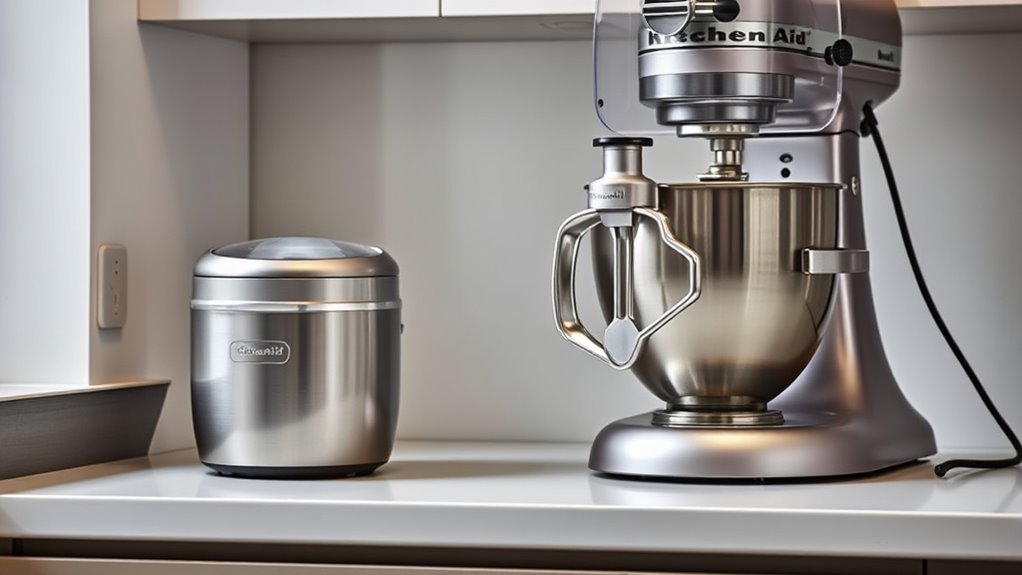
Ice cream makers generally require dedicated storage space for their main unit, which can be sizable and needs to be kept accessible in your kitchen. When considering storage options, think about whether you have enough room for the machine itself and its accessories. A bulky ice cream maker might need a dedicated spot on a countertop or in a cabinet, which could limit space for other appliances. In contrast, the Kitchenaid attachment offers better space optimization since it’s compact and stores easily within your existing mixer. If space is tight, the attachment could be a smarter choice, freeing up valuable storage. Overall, evaluate your kitchen layout to ensure your chosen option fits comfortably without cluttering your workspace or creating inconvenience.
Energy Consumption and Efficiency
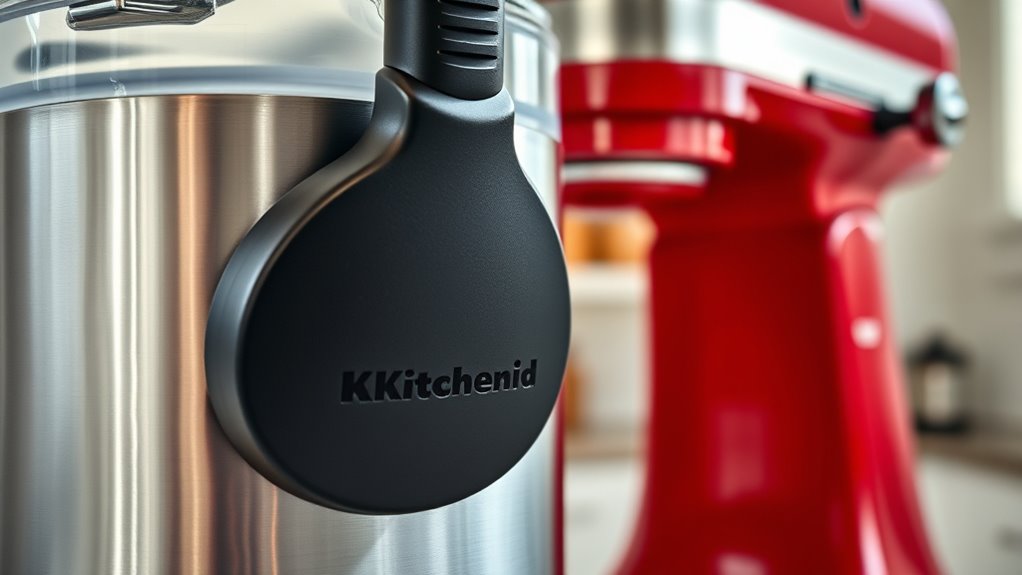
Choosing between an ice cream maker and a KitchenAid attachment often depends on their energy use, as efficiency can impact your electricity bill and environmental footprint. Ice cream makers typically have higher power consumption because they operate independently with their own compressors, consuming more energy during use. In contrast, KitchenAid attachments leverage your mixer’s power, which usually results in lower additional energy consumption but may extend the overall operation time. To compare energy efficiency, consider these points:
Ice cream makers use more energy than KitchenAid attachments, which are more efficient but may take longer.
- Ice cream makers generally consume more electricity per cycle due to their built-in refrigeration.
- KitchenAid attachments use less energy but rely on the mixer’s motor, impacting overall power consumption.
- Extended use of attachments can increase total energy use, even if individual power consumption remains low.
Choosing the more energy-efficient option depends on your usage habits and the appliance’s design.
User Experience and Satisfaction
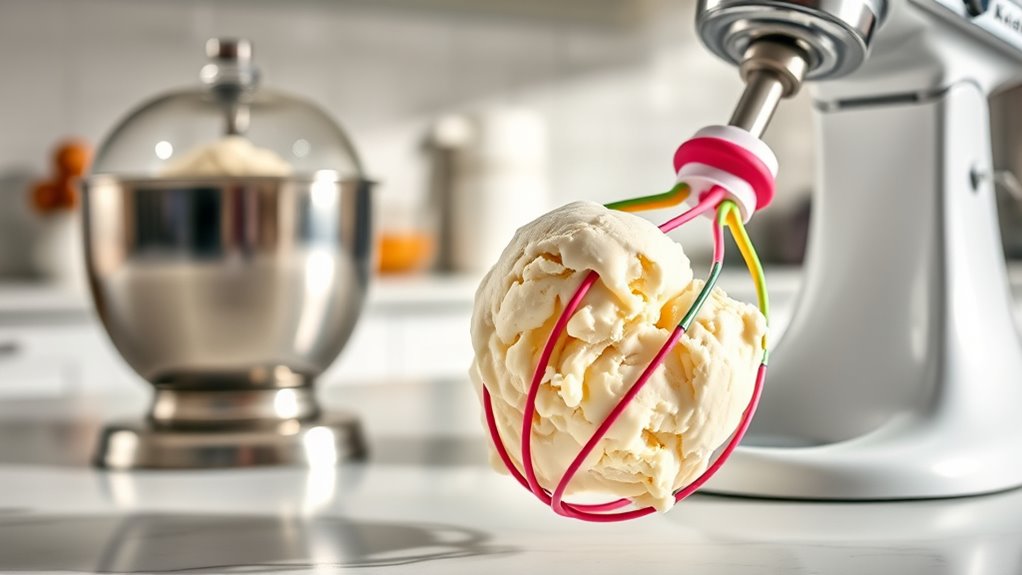
When it comes to user experience and satisfaction, personal preferences and ease of use matter most. You want consistent flavor and smooth texture, which depends on the machine’s performance. Ice cream makers often deliver better flavor consistency because they control freezing more precisely. Noise levels can influence your enjoyment; quieter devices make the process more pleasant. To help you decide, here’s a quick comparison:
| Feature | Ice Cream Maker | Kitchenaid Attachment |
|---|---|---|
| Flavor consistency | Usually more uniform | Slight variations |
| Noise levels | Generally quieter | Can be louder |
| Ease of use | Simple, standalone device | Requires mixing bowl |
Your satisfaction depends on what you value most—ease, noise, or flavor.
Frequently Asked Questions
Can Both Appliances Make Dairy-Free Ice Cream?
You can definitely make dairy-free ice cream with both appliances. They offer great appliance versatility, allowing you to experiment with various dairy-free options like coconut milk, almond milk, or cashew cream. Just follow your favorite recipes and adjust ingredients as needed. Both devices handle dairy-free ingredients well, so you get delicious, creamy results without dairy, making them perfect for those with dietary restrictions or preferences.
Which Option Is Quieter During Operation?
You might think all appliances are equally noisy, but the truth is, noise levels vary. During operation, you’ll notice that motor noise can be surprisingly loud, making it hard to enjoy your kitchen’s peace. Ironically, the quieter option often comes with a less powerful motor, so you get peace and quiet at the expense of speed. Choose carefully, because silence isn’t always synonymous with efficiency.
Are Replacement Parts Readily Available for Each?
You’ll find that replacement parts for both options are generally available, but the availability varies. The ice cream maker often has more specialized replacement parts, which can sometimes be harder to find over time. The Kitchenaid attachment benefits from the brand’s widespread support, making replacement parts more accessible and durable. Overall, consider availability and durability when deciding, as both options typically offer decent support, but Kitchenaid tends to have a slight edge.
How Long Do They Typically Last With Regular Use?
When considering how long they last with regular use, you’ll find that durability varies. Ice cream makers typically last around 3-5 years with proper maintenance, while Kitchenaid attachments can last longer if you follow their maintenance requirements carefully. Regular cleaning and avoiding overuse help extend their lifespan. Keep in mind, quality and frequency of use impact durability, so choose a model that fits your needs and maintain it well.
Do They Produce the Same Quality of Gelato?
You’ll notice that the texture comparison between these options varies a bit; the standalone ice cream maker often produces a creamier, denser gelato, while the Kitchenaid attachment tends to be a bit lighter. When it comes to flavor consistency, both do well, but the dedicated machine usually offers a more uniform mix. Ultimately, your choice depends on whether you prioritize texture or convenience, but both can make tasty gelato.
Conclusion
As you weigh your options, picture your kitchen as a canvas—each tool a brushstroke shaping your perfect ice cream masterpiece. Whether the sleek stand mixer attachment or the dedicated ice cream maker wins, remember that your choice crafts more than dessert; it creates memories. So, pick the one that fits your style, budget, and space, and turn your culinary dreams into a delicious reality. After all, the best choice is the one that brings your sweet visions to life.
